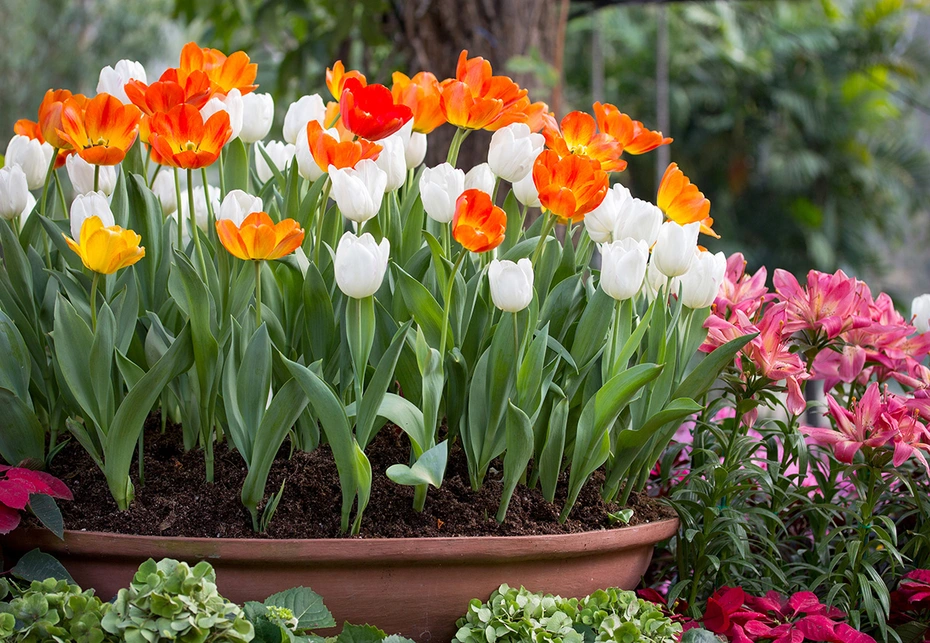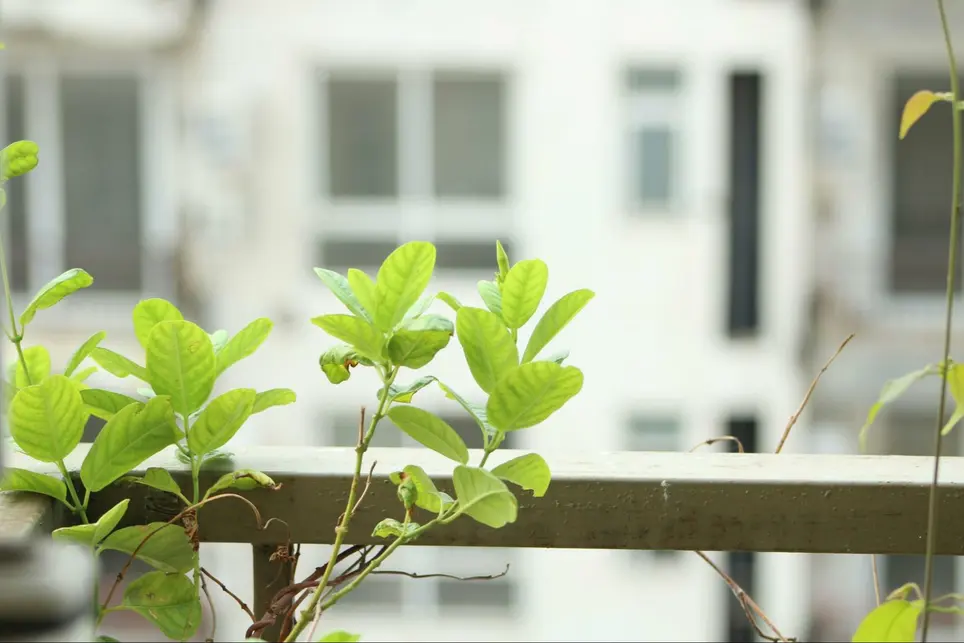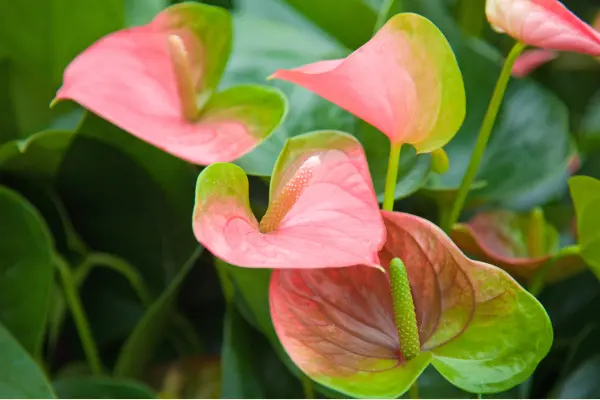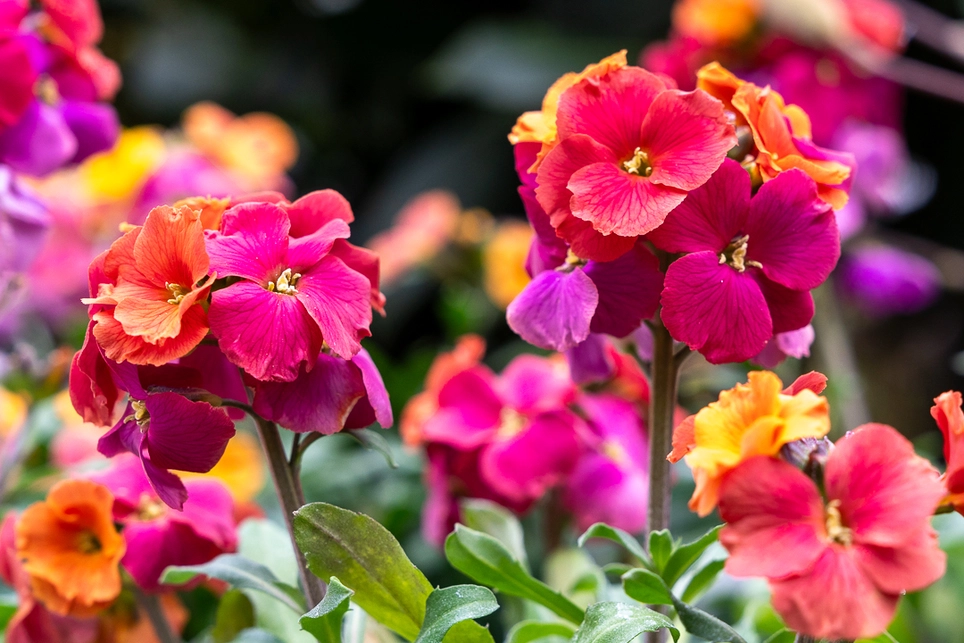
The Best March Gardening Tips From London Garden Experts
As March rolls in, the city garden is ready for its spring debut—whether you’ve got a quaint balcony or a more spacious patch in the suburbs. With London’s ever-changing weather, there’s no better time to kickstart your garden.
It's a month filled with potential, where the careful selection of spring plants can transform dormant patches into vibrant displays. This month, we’re focusing on how to make your outdoor space blossom, whether it’s a small patio with borders or a large outdoor garden space.
From potted spring bulbs to hardy perennials, we’ll show you how to get your garden thriving with a mix of essential tips and key gardening jobs to do in March. You’ll also find our suggestions for the best plants for March gardening, some stunning garden design inspiration, and a few witty suggestions along the way.
6 Essential Gardening Tasks & Tips for March
March is the month to set the tone for the year ahead. Here are some essential tips and gardening tasks for March to get started with.
- Let’s start with the basics—give your space a fresh start. Clear away the remnants of winter: the fallen leaves, dead stems, and any debris that’s cluttering up the place. This tidy-up doesn’t just make your garden look good—it helps prevent diseases from taking root. You’ll be setting the stage for healthier plants when they start growing this month.
- Once that’s done, let’s talk soil. Urban soil can sometimes feel a bit tired, so add some well-rotted compost or manure to replenish it. The nutrients will give your plants the best shot at thriving. Think of it like giving your garden a fresh cup of coffee—it wakes up and gets ready to perform. If you’re working with window boxes or planters, it’s a good time to refresh them with fresh compost too. Terracotta, glazed, or polystone planters are ideal for adding character and texture, so think about upgrading them for a more stylish and practical garden solution.
- Pruning is another one of your first steps—cut away any dead branches from shrubs and trees to make room for new growth. This helps your plants direct their energy towards fresh shoots and promotes healthier growth.
- Mulching is another key job. A healthy layer of mulch locks in moisture, suppresses weeds, and provides nutrients. It’s like an eco-friendly blanket for your plants. You can use bark chips or leaf mould to give your garden that extra layer of love. For those with smaller spaces, adding mulch to your potted plants or window boxes will keep everything in tip-top condition.
- And for those who love to get their hands dirty, it’s time to start planting! Spring flowering bulbs like Daffodils, Muscari (Grape Hyacinths), and Fritillaria add early bursts of colour to your space. If you’ve got space in pots or garden beds, Allium and Crocus will keep your garden looking lively throughout the month. For a more vibrant display, try combining the softer hues of Snowdrops with the bolder, more colourful Tulips.
- If you’re into growing your own food, now’s the time to sow vegetable seeds like radishes, lettuces, and spring onions. You could even add a few Nasturtiums or Pansies to your pots for an edible and decorative display. For the herb enthusiast, sowing Chives, Basil, or Mint now gives them a good head start. By mid-spring, you’ll be harvesting them right outside your kitchen window.

Applying a generous layer of mulch around your plants to supress weeds, retain soil moisture, and regulate soil temperature
Early Spring Watering, Pests, and Disease Management Tips
Gardening in March means you need to keep an eye on your plants’ water needs, especially with the unpredictable weather. The trick is deep, infrequent watering—enough to soak the roots but not drown them. Watering early in the morning helps, as it reduces evaporation and gives the soil a chance to absorb moisture before the sun kicks in.
On the pest front, be vigilant. As the temperature creeps up, you’ll start to see pests become more active. Check your plants regularly for early signs of any infestations. A spritz of neem oil or insecticidal soap will sort them out without harming the good bugs.
Don’t forget to check the underside of leaves—aphids love to hang out there!
The Best Plants For March: Design Ideas and Display Tips
March gardening (particularly if you live in an urban area) isn’t just about function—it’s about making the most of your space and creating something beautiful, no matter how small or grand. With a bit of creativity, your outdoor space can be a showpiece, whether it’s a compact balcony or a larger suburban garden.
Let’s dive into some fresh March garden design and planting ideas that will help you make your garden as vibrant as it can be, no matter your space limitations.
March Containers and Potted Garden Ideas
Container gardening is the ultimate solution for urban gardens, especially when space is limited. With a variety of sizes and shapes, pots can transform any balcony, patio, or windowsill into a lush garden. Start by selecting containers that complement your space—glazed terracotta or polystone pots work well for a more polished, stylish look, while aged terracotta gives a rustic feel that’s timeless and classic.
If you’re aiming for a pop of colour, you can’t go wrong with combining spring flowering bulbs like Crocus, Hyacinthus, and Narcissus (Daffodils) with some of the later-season blooms like Fritillaria or Tulips.
These bulbs look beautiful in large planters, and by planting a mix of early bloomers and later season varieties, you can ensure a stunning succession of flowers from March through May. The bold colours of Tulips, paired with the gentler hues of Snowdrops and Crocus, create a striking contrast that brightens up any space.
For a more fragrant container display, consider combining herbs like Lavender, Rosemary, and Sage with flowers such as Primrose or Pansies. Not only will this arrangement add a lovely scent to your garden, but it also serves a practical purpose. You can use the herbs in cooking or for making your own natural remedies.
Pot-grown bulbs for instant spring colour
Compact Plant Combinations For Small Gardens in March
If space is tight, think vertically. Vertical gardening techniques such as wall-mounted planters, hanging baskets, or trellis systems make the most of small spaces. Climbing plants like Sweet Peas, Clematis, or Thunbergia (Black-eyed Susan) are ideal for these setups. They’ll quickly climb and cover fences or railings, adding height and vibrancy without taking up valuable floor space.
For smaller containers, Violas, Cyclamen, and Dianthus (Pinks) are excellent choices. These compact plants thrive in pots and add a pop of colour to balconies, patios, or window boxes. You can also combine them with trailing plants like Ivy or Convolvulus cneorum (Silver Bush), which will spill over the edges of containers, creating a cascading effect.
Don’t overlook herbs in smaller spaces. Mint, Chives, and Basil grow happily in containers and will thrive on a sunny windowsill or balcony. For an aromatic display, add a few Oregano and Thyme plants, perfect for a herb garden that’s as practical as it is beautiful.
Add Borders and Beds for More Spacious Gardens
If you’re lucky enough to have a larger garden or space for borders and beds, you have a fantastic opportunity to incorporate a wider variety of plants. Start with a foundation of hardy, low-maintenance plants like Helleborus (Lenten Rose), Peonies, or Primroses.
These plants offer lasting beauty throughout spring and beyond. Combine them with Ajuga, Bergenia, and Brunnera to add texture and interest to your beds. These perennial plants thrive in most conditions and will come back year after year, making them a low-maintenance addition to your garden.
Consider adding shrubs like Camellia, Ceanothus, and Rhododendron to provide year-round structure. These plants create a solid foundation for your garden and add evergreen foliage that’s perfect for creating natural hedges or defining garden boundaries. Forsythia and Viburnum are great options for early spring blooms, giving your garden a burst of yellow and white before other plants get going.
To create a more dynamic, layered look, plant taller shrubs like Photinia or Pittosporum in the back of borders, and use smaller shrubs like Euonymus or Daphne in the front. These pairings create contrast in both size and texture.
Add flowering perennials like Erysimum (Wallflower), Iberis (Candytuft), or Phlox subulata to fill in the gaps and bring seasonal interest throughout the year.
Create Garden Borders with Textural Contrast
For a truly striking March garden, use a mix of evergreen shrubs and colourful flowering plants. Create a border that brings together plants like Lavender, Phormium, and Cotoneaster for texture contrast.
This combination brings structure and formality to the garden, with Lavender’s purple blooms contrasting beautifully with the bold leaves of Phormium (New Zealand Flax) and the bright red berries of Cotoneaster.
Add a dash of colour with Nasturtium or Pansy planted along the edges of the border, where they can spill over the sides and cascade towards the ground. For contrast, plant Hollyhocks or Papaver (Poppies) towards the back of the bed—these plants grow tall and create vertical interest while offering vibrant flowers in the summer months.
Olives provide a sculptural element to beds and borders
Craft a Seasonal Transition with Mixed Plantings
If you enjoy a garden that evolves throughout the year, try planting a mix of winter interest plants and spring blooms. For example, Skimmia, Helleborus, and Viburnum offer evergreen structure, while Cyclamen, Anemone Blanda, and Ranunculus provide bright, colourful spring blooms. This creates a seamless transition as one season fades into the next, with plants that continue to thrive and surprise you as the months progress.
For a more seasonal bed, try planting potted spring bulbs like Bluebells, Crocus, Muscari, and Tulips, which are ready to bloom and bring an explosion of colour to your space. These bulbs will fill your garden with vibrant hues and can be planted directly in pots, window boxes, or garden beds.
As they flower in early spring, follow up with late spring perennials like Peonies, Allium (Ornamental Onion), or Phlox for continued interest and colour as the season progresses. Potted bulbs will ensure your garden remains alive with colour from March right through to summer.
Use Planters for Statement Gardens
For a bold, statement-making look, opt for larger, architectural planters—these can act as focal points on patios, in corners of gardens, or along pathways. In larger planters, you can combine statement plants like David Austin Roses—choose the climbing varieties to take advantage of vertical space—along with Iberis, Erysimum (Wallflower), or Heuchera for a softer, textural contrast.
Create a layered planting effect in large pots by combining tall plants like Cordyline or Fatsia with lower-growing Primroses, Bellis perennis (Double Daisy), or Pansy. This mix will create a balanced look that thrives in both sun and shade.
Consider the theme you want to evoke in your container displays. For a Mediterranean-inspired feel, plant Olives, Lavender, and Thyme alongside Pansies or Nasturtium for bright, sunny colour. For a more tropical vibe, try Cordyline, Phormium, and Canna lilies, which bring striking foliage and fresh growth of bold flowers to your garden.
Bring in Some Edibles
Gardens aren’t just about ornamentals—why not incorporate edible plants into your design?
You can create a stylish and practical herb garden with herb plants like Oregano, Rosemary, Basil, Coriander, and Thyme. These plants thrive in containers and window boxes and will provide fresh herbs for your kitchen all season long.
Edible flowers such as Nasturtium, Viola, and Pansy make excellent additions to both your garden and your plate. You can use them in salads or for garnishes, making your garden both visually stunning and practical. Plus, they attract beneficial insects, adding to your garden’s overall health.
March is also the time to plant early potatoes. For the best results, ‘chit’ them first by leaving them in a cool, bright, frost-free place for a few weeks to produce shoots, then plant them in grow bags or vegetable beds. Don’t worry if you haven’t chitted your potatoes – just go ahead and plant them.
Herb plants grown in patio terracotta pots are exciting and perfect for the garden and cooking
The Best Flower Seeds To Sow in March
If it’s been a very cold, wet spring, wait until the weather improves and the soil warms enough to sow outdoors, or start your seeds off indoors. As a rule of thumb, if the weeds are starting to grow, it’s probably warm enough to sow hardy annuals outside.
Getting the watering right is one of the most important aspects of growing young plants from a seed. Seeds sown outdoors need regular watering in dry periods. For seeds sown indoors, keep the garden compost moist, but remember that seeds don’t enjoy sitting in sodden compost or soil surface.
Best indoor seeds to sow in March
- Sow half-hardy annuals like cosmos, cleome, antirrhinum (snapdragons), French marigolds and calendula (pot marigolds).
- Dahlia mixes - many are available as seeds and can be sown indoors now, giving a fabulous display in summer for very little cost.
- Climbing annuals like Thunbergia alata (Black-eyed Susan), Ipomoea lobata (Spanish Flag) and Ipomoea purpurea (Morning Glory) – these can be planted out as soon as the frosts are over and will quickly cover an obelisk, arch or pergola with their colourful flowers.
- In cold areas, sow sweet peas indoors in root trainers – toilet roll inner tubes work well, giving the long roots space to develop.
Best outdoor seeds to sow in March
- Hardy annuals, including Californian poppies, cornflowers, Nigella (love-in-a-mist) and sunflowers. March is also an excellent time to sow annual wildflower mixes.
- You can sow sweet pea seeds directly outdoors this month in mild areas, provided there’s no risk of frost.
- Nasturtiums are a great addition to any kitchen garden and can be sown outdoors from late March.
- If the weather is good, try sowing some night-scented stocks (Matthiola bicornis) in a sunny spot near a seating area to enjoy the delicious fragrance on long summer evenings.
Embrace March Gardening with Boma Garden Centre
It's time to take the first step-start with a plan, grab your tools, and watch your garden come to life. Spring is just around the corner, and your garden is about to shine.
Visit Boma Garden Centre this March to find everything you need to kickstart your spring garden. Our knowledgeable staff are on hand to help you select the perfect spring plants, bulbs, and accessories to bring your garden dreams to life.
Look out for Boma's special offers this March to help kickstart your spring gardening. Whether you're after a fresh batch of perennials, stylish pots and planters, or potted bulbs to brighten up your space, Boma has everything you need to transform your outdoor area.
If you're looking for more than just a bit of planting, we also offer Boma's Planting Service, perfect for those looking to give their garden, beds, borders, or planters a complete makeover. Our expert team can help you design and refresh your space, adding vibrant colour and structure that will last well beyond the season.















